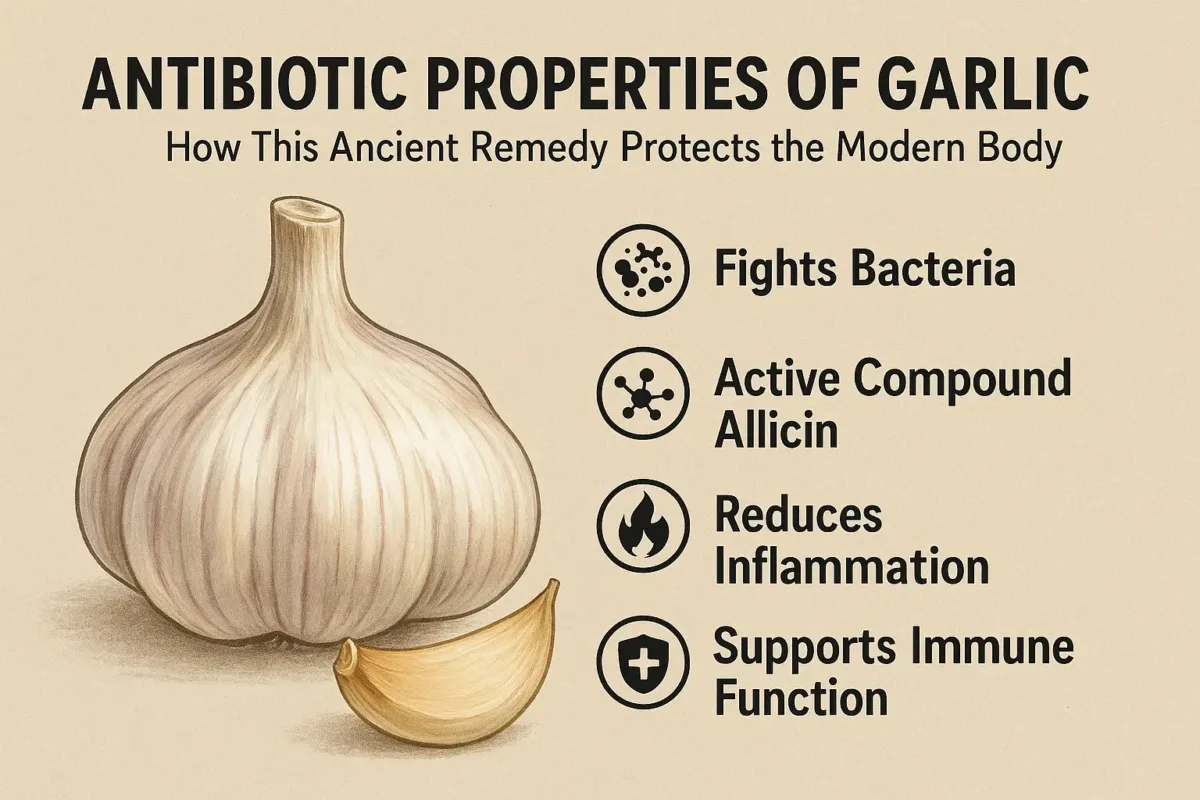Antibiotic properties of garlic have been whispered through kitchens and clinics for centuries. From monastery gardens to modern labs, this pungent bulb has earned a reputation as nature’s quiet defender—subtle, reliable, and beautifully compatible with the body. In a world that often reaches for quick fixes, garlic invites us to remember that healing can be simple and steady, provided we understand how it works and where its limits lie.
- What Makes Garlic Antibacterial? The Alchemy of Allicin
- Garlic vs. Modern Antibiotics: Partners, Not Rivals
- How to Activate and Preserve Garlic’s Power
- Evidence-Informed Uses (Home, Kitchen, and Care)
- Beyond Allicin: The Wider Chemistry of Garlic
- What the Research Says (Summarized Clearly)
- Safety, Side Effects, and Interactions of Garlic
- Garlic in Cultural Healing: A Brief History
- How to Build a Garlic Routine You’ll Actually Keep
- Common Myths—And Gentle Corrections
- When Home Care Isn’t Enough
- FAQs
- Is garlic really an antibiotic?
- How much raw garlic should I take?
- Does cooking destroy garlic’s benefits?
- What’s the safest way to use garlic for a sore throat?
- Can garlic help with antibiotic resistance?
- Are garlic supplements effective?
- Is topical garlic safe?
- Who should avoid high doses of garlic?
- How do I store garlic?
- Can children use garlic remedies?
What Makes Garlic Antibacterial? The Alchemy of Allicin
Garlic’s antimicrobial force rests on a delicate transformation. Inside each clove live two separate compounds—alliin and the enzyme alliinase. When garlic is crushed, chopped, or chewed, alliinase converts alliin into allicin, a highly reactive sulfur molecule. This is the moment the familiar garlic aroma blooms—and the moment antimicrobial chemistry begins.

Allicin disrupts bacterial life by oxidizing thiol-containing enzymes needed for metabolism and replication. This multi-target action makes it harder for microbes to develop resistance. In lab studies, allicin inhibits a wide range of bacteria including Staphylococcus aureus, Escherichia coli, Salmonella, and some strains that resist common drugs. Garlic also shows antifungal and antiviral activity, giving it a broad supportive role in everyday wellness.
Garlic vs. Modern Antibiotics: Partners, Not Rivals
Comparisons to penicillin are inspiring but imperfect. Pharmaceuticals deliver rapid, high-concentration systemic effects—essential for serious infections. Garlic is gentler and slower; it supports the body’s defenses rather than replacing them. Think of garlic as a terrain shaper: it alters local conditions so microbes struggle, inflammation cools, and immune cells work with less friction. Used consistently in food and thoughtfully as a remedy, it complements modern care and may reduce the need for frequent antibiotics for minor issues.
How to Activate and Preserve Garlic’s Power
- Crush, then wait: After chopping or pressing, let garlic rest for 10 minutes. This gives alliinase time to create allicin.
- Avoid high heat: Cooking deactivates alliinase. Add raw garlic toward the end of cooking, or use a mix of raw and cooked for flavor and function.
- Use fresh cloves: Pre-minced jars lose potency. Whole bulbs stored in a cool, dry place keep enzymes viable longer.
- Go small and steady: Daily culinary use is more sustainable than occasional large doses.
Evidence-Informed Uses (Home, Kitchen, and Care)
1) Raw Garlic Honey Elixir
Crush 3–4 cloves, let rest, and mix with 1 tablespoon raw honey. Take a small spoon daily during cold season. The honey soothes mucosa while garlic provides antimicrobial support.
2) Lemon-Garlic Warm Drink
Combine warm water, juice of half a lemon, and a clove of rested, finely minced garlic. Sip slowly. Add honey after the liquid cools below hot to protect beneficial enzymes.
3) Garlic in Dressings and Dips
Stir raw garlic into yogurt dips, pesto, or tahini just before serving. This keeps allicin intact and supportively present in meals you already love.
4) Topical Traditions—With Caution
Historically, crushed garlic was applied to wounds, but direct application can burn skin. For modern home care, avoid raw garlic on open wounds. If using on intact skin (e.g., nails), dilute in carrier oil and patch-test first.
Beyond Allicin: The Wider Chemistry of Garlic
Allicin is only the beginning. As it breaks down, it forms a constellation of sulfur compounds—ajoene, diallyl disulfide, and others—that continue to influence microbes and inflammation. Aged garlic extracts, which contain stable sulfur molecules, show benefits for cardiovascular health and immune modulation, supporting the idea that garlic is both an antimicrobial and a system balancer.
What the Research Says (Summarized Clearly)
- Raw garlic extracts inhibit multiple bacteria in vitro and may help with mild, surface-level issues.
- Garlic can work synergistically with certain antibiotics, potentially reducing required doses in early laboratory models.
- Aged garlic extract supports immune function and may reduce cold frequency and severity in some studies.
- Human trials are more mixed than petri-dish studies; realistic, food-level use is the best approach for most people.
Safety, Side Effects, and Interactions of Garlic
Garlic is food—but it is also strong medicine. Too much raw garlic can irritate the stomach, cause heartburn, or worsen dermatitis when applied to skin. It may increase bleeding risk in people on anticoagulants and can interact with certain medications. Reasonable daily culinary use—1 to 2 cloves—is well tolerated for most adults. If you’re pregnant, managing a medical condition, or taking prescription drugs, consult a professional before using concentrated extracts.
Garlic in Cultural Healing: A Brief History
From Egyptian pyramid workers to Greek athletes, garlic was taken to ward off illness and fatigue. In Asia, it was blended into tonics with ginger and vinegar. During the world wars, medics used garlic poultices when supplies ran low. These stories aren’t mere folklore; they’re threads of observation that modern science continues to validate in part.
How to Build a Garlic Routine You’ll Actually Keep
- Morning: Warm water with lemon, then breakfast with a raw-garlic dressing or pesto.
- Lunch: Add a clove to soups or stews near the end of cooking to preserve some activity.
- Evening: Garlic yogurt dip or hummus; a small honey-garlic spoon if scratchy throat returns.
- Weekly: Roast whole bulbs for flavor and comfort; combine with raw uses for balance.
Common Myths—And Gentle Corrections
- “Garlic equals penicillin.” Garlic supports; penicillin treats systemic infections. Use both wisely as needed.
- “More raw garlic cures faster.” Excess can damage the gut lining; steady, moderate intake works better.
- “Garlic oil is safe for every use.” Homemade garlic oil can harbor botulism if improperly stored. Never place oils in ears; consult professionals.
When Home Care Isn’t Enough
Seek medical attention for high fever, spreading redness, severe pain, breathing issues, or symptoms that worsen beyond 48–72 hours. Garlic can support recovery, but serious infections require timely diagnosis and treatment.
FAQs
Is garlic really an antibiotic?
Garlic has antibacterial, antifungal, and antiviral activity, especially when raw and freshly crushed. It’s best used as a complementary remedy for mild issues.
How much raw garlic should I take?
Most adults do well with 1–2 cloves daily in food. Larger amounts can irritate digestion.
Does cooking destroy garlic’s benefits?
Heat inactivates alliinase, which means less allicin. Use a mix of raw and lightly cooked preparations.
What’s the safest way to use garlic for a sore throat?
A small honey-garlic mixture, taken after resting the crushed garlic, coats the throat and offers gentle antimicrobial support.
Can garlic help with antibiotic resistance?
Garlic’s multi-target action makes resistance less likely, and early research shows synergy with some antibiotics—but it’s not a replacement for prescriptions.
Are garlic supplements effective?
Stabilized allicin or aged garlic extract can be helpful. Quality and standardization matter—buy from reputable brands.
Is topical garlic safe?
Use caution. Raw garlic can burn skin. If used on intact skin, dilute in carrier oil and patch-test first.
Who should avoid high doses of garlic?
People on blood thinners, those with stomach ulcers, or with known allergies should limit use and consult a clinician.
How do I store garlic?
Keep bulbs in a cool, dry, ventilated place. Avoid refrigeration, which can encourage sprouting and alter flavor.
Can children use garlic remedies?
Small culinary amounts are fine; avoid strong, raw preparations for young children due to digestive sensitivity.
Each clove of garlic is a small act of memory: the garden, the kitchen, the healer’s hands. Used with respect, it doesn’t replace modern medicine—it helps your body meet it halfway.
If this spoke to you, you’ll love the full information in this book; begin your deeper reading → See the book on Mayobook.


